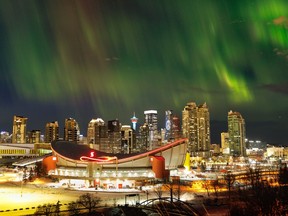'Quite the show': Northern lights shimmer over Calgary, a likely trend ...
The bright green aurora was seen hovering directly over Calgary on Sunday night and Monday morning
Published Feb 27, 2023 • Last updated 1 hour ago • 3 minute read
Join the conversation
 A midnight blast of northern lights over downtown Calgary, Alta., on Sunday, Feb. 26, 2023. Photo by Mike Drew /Postmedia
A midnight blast of northern lights over downtown Calgary, Alta., on Sunday, Feb. 26, 2023. Photo by Mike Drew /Postmedia Calgarians who poked their head outside late Sunday and early Monday morning were treated to solar activity that produced glittering northern lights over the city.
Create an account or sign in to continue with your reading experience.
Access articles from across Canada with one account Share your thoughts and join the conversation in the comments Enjoy additional articles per month Get email updates from your favourite authorsFootage of the aurora was captured by a number of city residents, with many angles showing the lights shimmering directly above Calgary.
Sign up to receive daily headline news from the Calgary Herald, a division of Postmedia Network Inc.
By clicking on the sign up button you consent to receive the above newsletter from Postmedia Network Inc. You may unsubscribe any time by clicking on the unsubscribe link at the bottom of our emails or any newsletter. Postmedia Network Inc. | 365 Bloor Street East, Toronto, Ontario, M4W 3L4 | 416-383-2300
“Last night we were treated to quite the show that was even visible through the light pollution of YYC,” tweeted one observer.
It’s been a good month for aurora watchers; less than two weeks ago a significant geomagnetic storm resulted in northern lights appearing over several parts of Canada.
‘The strongest we’ve seen’The aurora was one of the most vivid displays rural Calgary resident Bob Sleik has seen in recent years.
“It’s not too often you see them get to that level,” said Sleik, a longtime northern lights enthusiast who runs his own aurora forecasting website.
His eyes weren’t deceiving him, either. The geomagnetic storm was the first G3 storm since April 2022, according to Rob Steenburgh, acting lead for the Space Weather Forecast Office at the U.S.-based National Oceanic and Atmospheric Administration.
Similar to hurricanes, solar storms are evaluated on a five-point scale. G3 storms often push the visibility of northern lights south into areas such as Calgary, whereas G1 and G2 storms are often restricted to regions farther north.
Steenburgh said Sunday’s storm was “probably on par with some of the strongest we’ve seen” in recent times.
At its peak, solar wind speeds hit approximately 850 km/second, according to Steenburgh. Normal solar wind speeds, he said, range from 300 to 400 km/second.
“I don’t think we’ve seen anything over a G3 in the last five years,” he said.
‘Stepping down a notch’ Monday nightWhile solar activity is unpredictable, Steenburgh said the most intense part of the storm is likely over. NOAA’s forecast is projecting activity to ramp down to G2 conditions by early evening, meaning northern lights may reach Calgary when the sun sets.
“We’d be going from strong to moderate, stepping down a notch,” he said.
Calgary’s skies may also be blanketed in clouds by evening, which are expected to move over the city overnight. Environment Canada is forecasting increasing cloudiness on Monday night and snow beginning in the morning.
 New pictures: Aurora borealis lights up skies over Calgary
New pictures: Aurora borealis lights up skies over Calgary  Calgary couple has close encounter with cougar near Canmore Activity expected to ramp up in coming years
Calgary couple has close encounter with cougar near Canmore Activity expected to ramp up in coming years Due to a more than decade-long cycle the sun undergoes, northern lights could become more common in areas such as Calgary over the next few years.
Peak solar maximum is when the star is most active and releases the highest number of sun spots, which eject charged particles that clash with Earth’s magnetic field and subsequently cause auroras. Steenburgh said the sun is slowly approaching peak solar maximum, which is good news for aurora enthusiasts.
“There’s an increased likelihood that they’ll become more frequent, and with that increased frequency comes a higher potential they’ll hit Earth and (create) more opportunities for folks.”
Though the sun reduces activity once it passes its peak, it still maintains relatively high geomagnetic activity in the few years it’s sloping down, Steenburgh added.
“After we hit the crest, we’re on our way down … (but) that doesn’t rule out more excitement.”
Advice for aurora watchersWhile the geomagnetic storm was visible from areas across Calgary on Sunday, auroras are often less visible in the city due to light pollution, Sleik said.
He generally recommends interested aurora chasers find a dark area — often outside of the city lights, which can hamper visibility. The lights are often stronger in some of Calgary’s spacious parks, he added.
There are several apps and websites offering up-to-date information on solar activity around the world, including the app Aurora, SpaceWeatherLive and NOAA’s Space Weather Prediction Centre.
Catch a photo of the northern lights? Send them to [email protected].































































